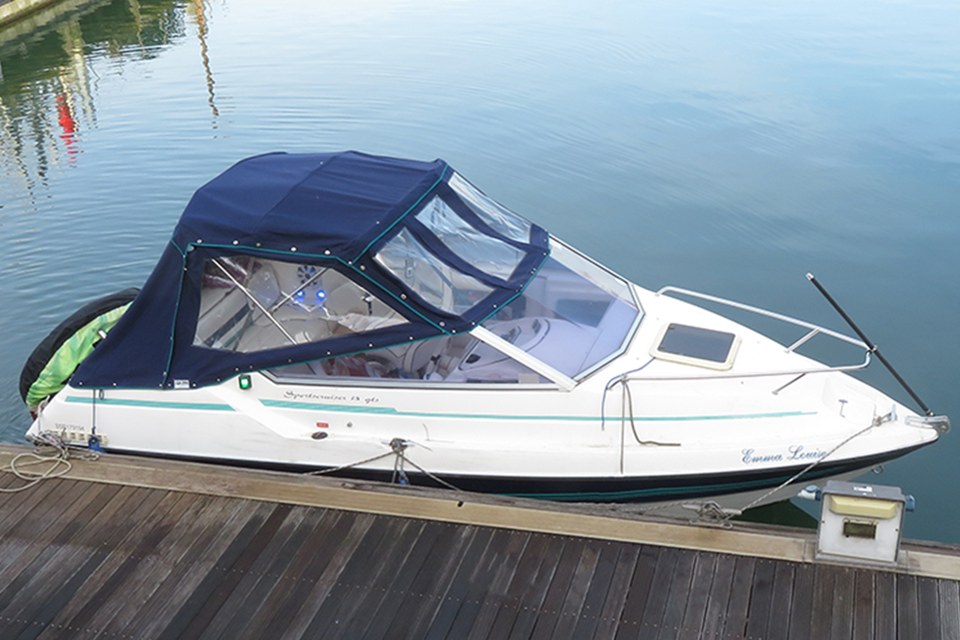Safety flyer to the recreational craft industry and pleasure craft users
Published 27 April 2023
1. Summary
Carbon monoxide poisoning, resulting in two fatalities on board the sports cruiser Emma Louise at Port Hamble Marina, River Hamble, England on 11 January 2022.

2. Narrative
On the morning of 12 January 2022, the bodies of two men were found on board the 5.5m sports cruiser Emma Louise, which was moored to a pontoon at Port Hamble Marina, Southampton. It was later established that they had both died as a result of carbon monoxide (CO) poisoning.
The sports cruiser’s 3 litre petrol-driven engine had been started when the two men boarded Emma Louise the previous evening and left idling, probably to charge the boat’s batteries. Exhaust gas from the waterline exhaust was likely funnelled between an inflatable towable ringo and the boat’s transom and seeped into the covered cockpit through small gaps where the boat’s canopy was fastened to the transom.
During tests with Emma Louise in its as found condition MAIB inspectors measured accumulated CO levels in the covered cockpit that were capable of causing damage to health and collapse within 35 minutes. With no CO detector fitted it is likely that the two men were unaware of the danger and were overcome soon after starting the engine, fell unconscious and died later that evening.
3. Safety Lessons
-
CO is always present in the exhausts of engines and appliances such as cabin heaters and portable generators that run on fossil fuel. CO is colourless, tasteless and odourless and difficult for people to detect. It is therefore essential that CO alarms are fitted in areas where CO can accumulate and pose a risk to health such as the cabins and cockpits of motor cruisers. When selecting a CO alarm, preference should be given to those that meet safety standard BS EN 50291-2:2010, which are designed for use in a marine environment. It is essential to fit detectors following manufacturer guidance, test them routinely using the test button and not ignore them should the alarm sound.
-
Exhaust gases containing lethal CO can accumulate inside a boat even when it is underway. Boat users should ensure that all spaces are well ventilated, including those under a canopy or awning. Never ignore the smell of exhaust fumes in any enclosed space.
-
Although external engine exhaust outlets are intended to discharge exhaust fumes into the open air, the wind, aerodynamic effects and the proximity of nearby structures can result in the fumes entering the boat. Boat users should ensure that exhaust outlets are clear from obstructions. In this instance, it is likely that the two men’s exposure to CO would have been at a much lower level and would not have resulted in their deaths if the ringo on the transom had not helped funnel the exhaust gas into the covered cockpit.
-
The symptoms of CO can be similar to those of a cold, the flu or a hangover; warning signs include headaches, dizziness, nausea, vomiting, tiredness, confusion, stomach pain and shortness of breath. Over the past 10 years, the MAIB has investigated five accidents that involved CO poisoning, including this one, which have resulted in the tragic loss of nine lives on pleasure boats. If CO poisoning is suspected, stop the source immediately, move to the open air and seek medical attention.
To support the UK government’s Carbon Monoxide Awareness Week 2022, MAIB’s Chief Inspector shared safety critical advice with boat users.
MAIB also released an information video with simple ways to keep you safe:
Extract from The United Kingdom Merchant Shipping (Accident Reporting and Investigation) Regulations 2012 – Regulation 5:
The sole objective of the investigation of an accident under the Merchant Shipping (Accident Reporting and Investigation) Regulations 2012 shall be the prevention of future accidents through the ascertainment of its causes and circumstances. It shall not be the purpose of an such investigation to determine liability nor, except so far as is necessary to achieve its objective, to apportion blame.
Note:
This safety flyer is not written with litigation in mind and, pursuant to Regulation 14(14) of the Merchant Shipping (Accident Reporting and Investigation) Regulations 2012, shall be inadmissible in any judicial proceedings whose purpose, or one of whose purposes is to attribute or apportion liability or blame.
Marine Accident Investigation Branch
First Floor, Spring Place
105 Commercial Road
Southampton
SO15 1GH
Email [email protected]
Enquiries during office hours +44 (0)23 8039 5500

